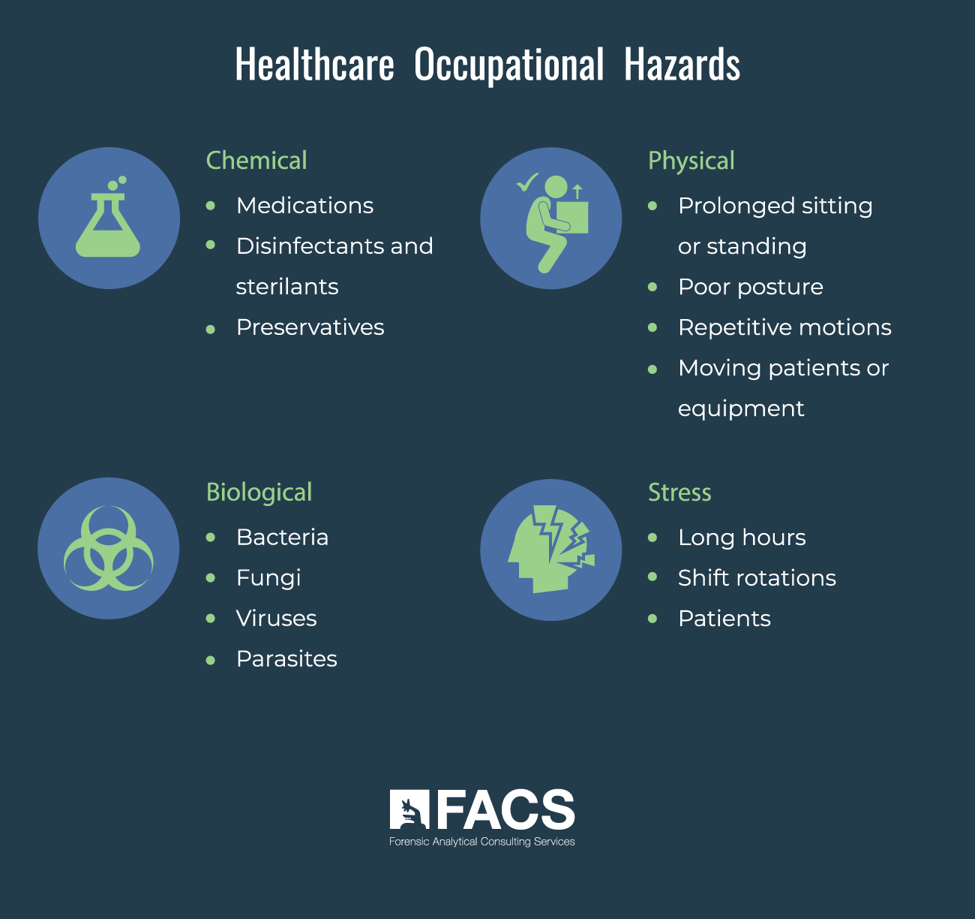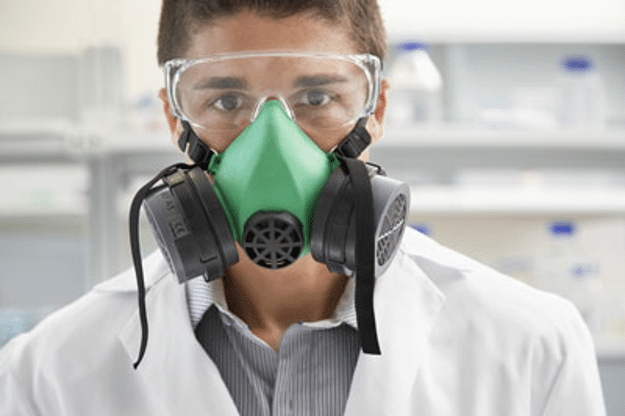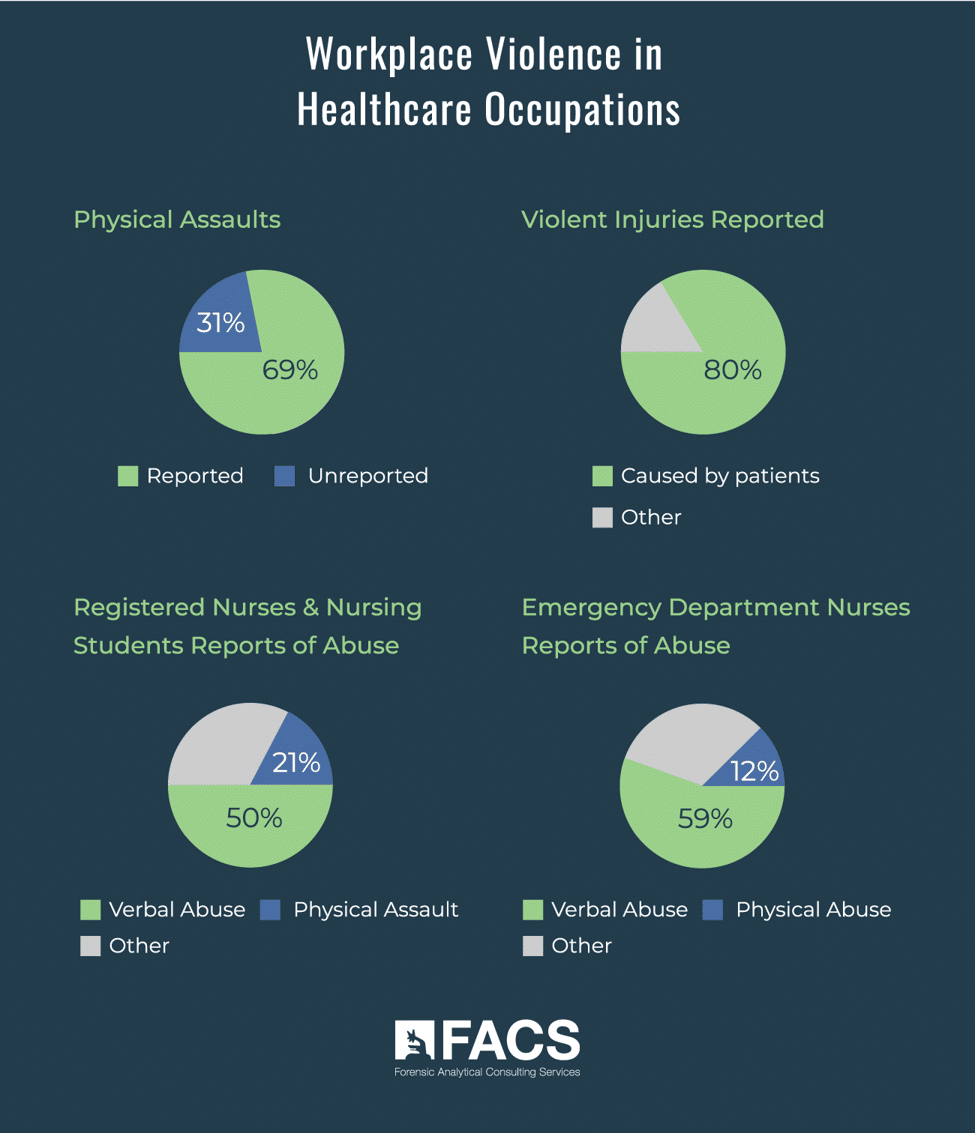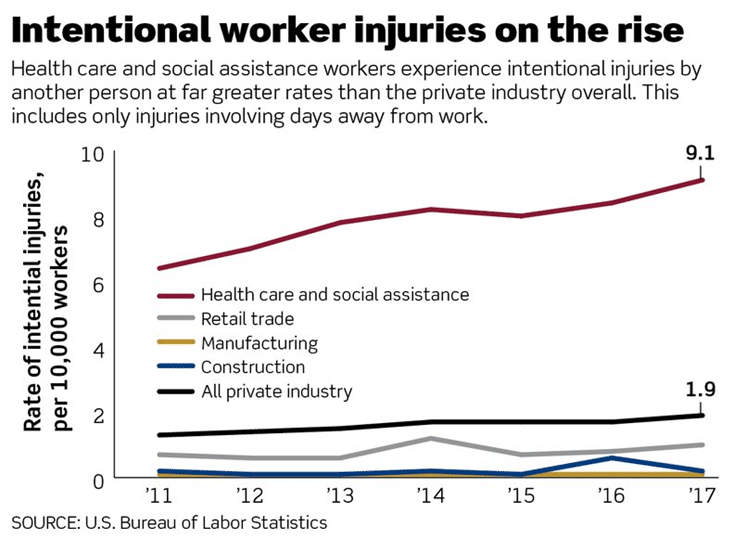When you visit someone in the hospital, you may take extra care to wash your hands when entering and leaving the building. You are probably also more aware of the surfaces you touch while inside, and you may even be concerned about the cleanliness of your shoes when you get home. Those are normal precautions that occur to most people who have cause to enter a healthcare facility.
If visitors are rightfully concerned about health risks in hospitals and clinics, though, consider the predicament faced by medical personnel: They show up for work and attend dutifully to their jobs in spite of significant risks to personal health and safety.

This article briefly summarizes the types of occupational risks healthcare (HC) workers encounter regularly. It also provides suggested resources that can help staff members anticipate, recognize, control, and seek to reduce daily threats to their health and safety.
Physical Hazards in Healthcare Occupations
Physical injuries, whether incidental or due to repetitive motions, are a major concern for HC workers. They often need to lift or reposition patients, move medical equipment, or perform other physical tasks — sometimes in a hurry. Those who learn and observe proper patient handling and lifting techniques are less likely to suffer injury.
All too often, injuries are caused or aggravated by repetitive motions, poor posture, and prolonged sitting or standing. Attention to the development of ergonomically sound workplaces can help prevent injuries and increase production.
Recommended resources:
- Safe Patient Handling and Mobility
- Ergonomics and Musculoskeletal Disorders
- Elements of Ergonomics Programs
Chemical Hazards in Healthcare Occupations
Various types of hazardous chemicals are used and stored in hospitals, clinics, and other healthcare-related buildings. These chemicals are routinely used to clean surfaces, sterilize instruments, and for other clinical purposes (including research).

Source: https://www.cdc.gov/niosh/topics/healthcare/prevention.html
Healthcare workers, patients, and others who are exposed to these substances may encounter significant personal danger. Where it’s not possible to prevent exposure completely, steps must be taken to protect the health of all concerned.
Here are some of the most common hazardous chemicals often found in healthcare facilities and examples of situations where they might be found:
- Patient care may include the use of hazardous substances like antineoplastic drugs, aerosolized medications, and anesthetic gases
- Surfaces are often cleaned with phenolic-based cleaning agents, quaternary ammonium compounds, and bleach
- Surgical equipment and instruments are treated with disinfectants/sterilants like peracetic acid, glutaraldehyde, and ethylene oxide
- Tissue specimen fixation, preparation, and preservation procedures typically require chemicals like formaldehyde and xylene
- Surgical smoke generated by lasers and electrosurgical devices during surgical procedures contains many chemical substances, but in some instances may also include infectious agents such as viruses or bacteria
The resources listed below provide suggestions on ways to prevent or limit human contact with hazardous chemicals in healthcare environments.
Recommended resources:
- Guideline for Disinfection and Sterilization in Healthcare Facilities
- Hazardous Drug Exposures in Healthcare
- Cleaning and Sterilization of Anesthetic Equipment
Biological Hazards in Healthcare Occupations
Biological hazards are organisms capable of causing infections or diseases. They include bacteria, fungi, viruses, and parasites. Healthcare workers have a high risk of coming in contact with infectious agents at work.
Consider the following examples of potential concerns:
- HIV/AIDS
- Hepatitis B
- Hepatitis C
- Influenza
- Ebola
- Methicillin-resistant Staphylococcus aureus (MRSA)
- Mycobacterium tuberculosis (TB)
- Severe acute respiratory syndrome (SARS)
- Middle East respiratory syndrome (MERS)
- Other coronaviruses
- Bodily fluids containing potentially infectious agents.
The examples given above compose just a partial listing of biological hazards confronting people in healthcare occupations. Knowing how to avoid contact and transmission — whether from bloodborne pathogens, bodily fluids, or airborne infectious agents — is essential for protecting those who care for the injured and ill.
Recommended resource:
Stress in Healthcare Occupations
In addition to the chemical, physical, and biological hazards already noted, healthcare settings also tend to be high-stress work environments. Some of the stressors include long hours at work, shift rotations, and the constant demands from patients, visitors, patients’ families, and other staff members.
Workplace stress increases the risk of injuries and accidents. Stress also reduces worker efficiency, production, and quality of life. Sometimes, the best way to get more done is to stop to rest and collect oneself before proceeding.
Recommended resources:
- Exposure to Stress: Occupational Hazards in Hospitals
- The Impact of Healthcare Workers Job Environment on Their Mental-emotional Health
- Preventing Occupational Stress in Healthcare Workers
Workplace Violence in Healthcare Occupations
Injuries related to workplace violence happen at greater rates in healthcare than in other sectors. According to a Bureau of Labor Statistics study, serious injuries due to workplace violence are 400 percent greater, on average, for healthcare and social assistance workers than for employees in other private industry occupations.

The Workplace Violence in Healthcare report by OSHA cites the following statistics:
- 80 percent of serious violent incidents reported in healthcare settings were caused by interactions with patients
- Only 69 percent of physical assaults and 71 percent of non-physical assaults were reported to a manager
- 21 percent of registered nurses and nursing students reported being physically assaulted—and over 50 percent verbally abused
- 12 percent of emergency department nurses experienced physical violence—and 59 percent experienced verbal abuse
- The most common causes of violent injuries resulting in days away from work were hitting, kicking, beating, and/or shoving
Disturbingly, the rate of HC workplace violence incidents continues to increase, as illustrated in the graph below:

In response to this growing problem, the California Department of Occupational Safety and Health (Cal/OSHA) enacted a Workplace Violence Prevention in Health Care standard (2017), and a federal bill — Workplace Violence Prevention for Health Care and Social Service Workers Act (H.R.1309) — is currently under consideration in the U.S. Congress.
Recommended resources:
- OSHA’s Guidelines for Preventing Workplace Violence for Healthcare and Social Service Workers
- Workplace Violence Prevention Training for Nurses
FACS Strategic Partnerships Help Control Risks in Healthcare Occupations
FACS is proud to be a strategic partner with healthcare facilities nationwide. Together, we develop programs aimed at preventing on-the-job injuries and illnesses to protect those who work so hard to protect others.
The next time you find yourself in a hospital or clinic, take a moment to reflect on and recognize the difficult conditions HC workers encounter daily. Then give a sincere “Thank you” to a staff member for their commitment to duty.
Significant resources are invested in the training of healthcare workers and the processes, procedures, and equipment used to protect them. Yet, much more work needs to be done. The success of any program is typically related to the quality of the strategic planning that gives birth to it.
FACS teams assist daily in the anticipation, recognition, evaluation and control of occupational health risks and to assist in training healthcare workers. The goal is to understand and minimize or eliminate the risks they face.
For further information, call (888) 711-9998 or use the FACS online contact form.
###